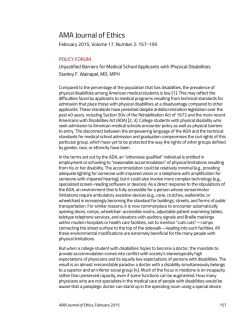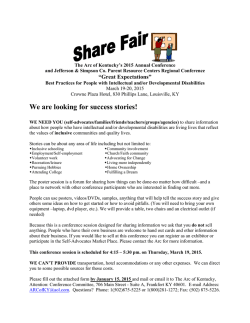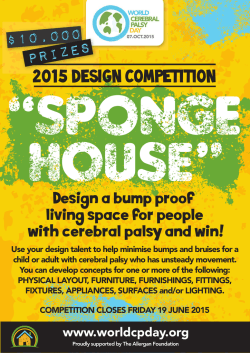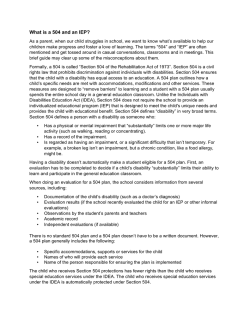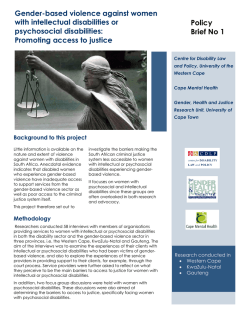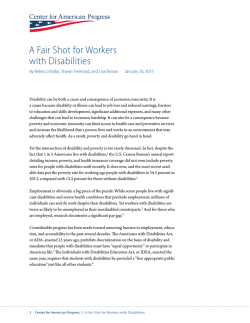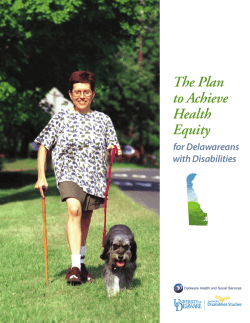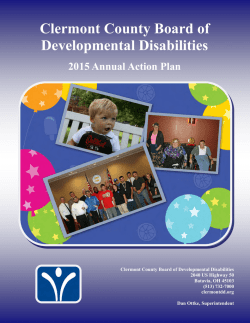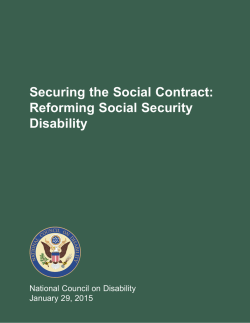
Because mental health matters submission (PDF 74 KB)
Because Mental Health Matters Submission to the Victorian Department of Human Services, in response to the Consultation Paper, May 2008 From The Bridging Project A mental health initiative by Scope and CDDHV Because Mental Health Matters Submission to the Victorian Department of Human Services, in response to the Consultation Paper, May 2008 Submission Authors A/Prof. Teresa Iacono Centre for Developmental Disabilities Health Victoria, Monash University Building 1, 270 Ferntree Gully Road NOTTING HILL 3168 Phone: 8575-2259 e-mail: [email protected] Dr. Nick Hagiliassis Scope (Vic) Ltd. 177 Glenroy Road GLENROY Phone: 8311-4038 e-mail: [email protected] Ms. Hrepsime Gulbenkoglu Scope (Vic) Ltd. 830 Whitehorse Road BOX HILL 3128 Phone: 9843 3000 e-mail: [email protected] Mr. Mark Di Marco Scope (Vic) Ltd. 177 Glenroy Road GLENROY Phone: 8311 4000 e-mail: [email protected] Ms. Jo Watson Scope (Vic) Ltd. 177 Glenroy Road GLENROY Phone: 8311 4000 e-mail: [email protected] Contact Person: A/Prof. Teresa Iacono 2 Introduction As psychologists and speech pathologists working with adults with developmental disabilities (in particular, cerebral palsy and intellectual disabilities), and also conducting research to address their needs, we are gratified by the potential offered within this Consultation Paper. This submission relates most directly to adults with complex communication and mental health needs, who are the focus of the Bridging Project (http://www.bridgingproject.org.au/). This project is being undertaken by Scope in collaboration with the Centre for Developmental Disability Health Victoria, Monash University. People with complex communication needs have speech and/or language that are not functional to meet their daily communication needs. People with developmental disabilities, in particular cerebral palsy and/or intellectual disabilities often have complex communication needs. They may rely on or have the potential to benefit from augmentative and alternative communication (AAC) systems, which include informal systems, such as natural gestures, and formal systems, such as signs (as adapted from those used by the Deaf), written communication, and graphic symbols that are accessed from a communication board or book, or high technology device. People with complex communication needs and people with mental illness or emotional disorders often feel hidden within the community and believe that others do not readily understand the difficulties that they experience or the problems that they have accessing necessary services. However, when people have both complex communication and mental health needs, the problems are significantly compounded. This project attempts to build bridges between specialist and community providers of mental health services in relation to people with complex communication needs and to provide information to all relevant stakeholders. The Bridging Project has as its mission to progress the knowledge and resource base to ensure that adults (aged 18 years+) with complex communication and mental health needs have access to quality services. This project has two streams, Building Evidence and Building Capacity and is based on combined and complementary research strategies. 3 Focus Area 1: Prevention & Focus Area 2: Early Intervention The foci on prevention (Focus Area 1) and early intervention (Focus Area 2) in this mental health initiative is in keeping with the recognition amongst clinicians and researchers in developmental disabilities of the need to identify and support key components of mental health. According to the Report by the Mental Health Special Interest Group of the International Association for the Scientific Study of Intellectual Disabilities to the World Health Organisation, Sept 2001 (p. 15) The social milieu in which people live constitutes an important contribution to resilience and the development of practical, social, and coping skills that may provide protection against the development of mental ill-health. The quality of social care and employment or occupational opportunities commensurate with individual abilities, and, most importantly, freedom from exploitation and abuse, are prerequisites for enhancing mental health and minimising the occurrence of behaviour disorders, as it would be for any group of people. Focus Area 1: Prevention Presently, people with disabilities and mental health issues tend to present in acute phases of their mental health condition, and often in association with behaviours of concern (i.e., problem behaviours). Preventative mental health could be enhanced through services delivered across the lifespan with an emphasis on the critical early years. In particular, programs that foster positive behaviours, ease family distress and support families of young children with disabilities to develop positive attachments could be strengthened. Strategies that address connectedness between assessment and service provision (including the removal of barriers created by silos) are needed for prevention or at least early detection and the implementation of early intervention as means to prevent acute and chronic psychiatric disorder. Focus Area 2: Early Intervention Early identification and intervention could be achieved through the development of mental health assessment tools and protocols accessible to people with a range of communication and cognitive abilities. This could also be better achieved through strategies that foster recognition that people with disabilities can have mental health problems that are real, painful, and sometimes severe, and that encourage carers to seek early and appropriate treatment and services. In light of the focus of our clinical, research and educative work, the remainder of our submission relates most directly to the Because mental health matters initiative Focus Area 5: Complex Clients and Focus Area 6: Workforce. 4 Focus Area 5: Complex Clients Comment on the Extent of Mental Health Problems in People with Complex Communication Needs On p. 89 of the Consultation paper, it is estimated that 14,000 Victorians have a dual disability (intellectual disability and mental health needs). It is difficult to determine the basis of this estimation, particularly in light of problems identifying or locating all Victorians with intellectual disability, a lack of appropriate psychiatric assessment tools for people who have difficulties selfreporting internal states, and a mental health workforce with limited skills in developmental disabilities. However, what is certain is that sub-groups of the population of intellectual disabilities will not have been included or be substantially under-represented in this estimation: in particular, people with cerebral palsy (not all of whom have an intellectual disability) and those with mild intellectual disability who may not be registered as having a disability. We do know from our own and international research that people with developmental disabilities are particularly susceptible to depression. The vulnerability of people with cerebral palsy to depression, for example, arises because of their high incidence of health problems, difficulties forming intimate relationships because of few opportunities and societal barriers, educational demands, problems accessing employment opportunities, lack of opportunities for self-determination, and frequent experiences of different forms of abuse. In fact, depression has been considered by some experts as a secondary health condition of cerebral palsy. Although it is suspected that chronic health issues, along with the experience of a life-long disability, are associated with depression in people with cerebral palsy, the extent of these associations has not been researched. Other data pointing to the extent of mental health problems in this group comes from clinical audits conducted by members of the Bridging Project. These have revealed that 11% of people accessing psychological services at Scope were diagnosed with a psychiatric disorder, most commonly depression, but very few (approximately 4%) were accessing services. The prevalence rate of 11% was considered an underestimate in light of overshadowing (ie attributing all symptoms to CP), poor early detection, a lack of appropriate assessment tools, and attitudinal factors. Goal 5.1. Promoting a more coordinated and tailored approach to people who require support from multiple services We applaud this goal, which is particularly relevant for people with complex communication and mental health needs. Given that addressing the needs of this group requires specialist knowledge in the most appropriate psychological and psychiatric approaches, and knowledge and skills in nonspeech modes of communication, including AAC, we feel it is essential that such specialist disability services be included within the coordinated, tailored and multi-agency approach. We are particularly concerned that people with complex communication and mental health needs will be omitted from this strategy because of the lack of tools available for their mental health 5 assessment, and the difficulties service providers would face in adapting their intervention strategies without support or input from specialist service providers. The long term benefits include the skilling of the various agencies in addressing the specific needs of this group, and access to strategies that will be useful to other groups, such as those with communication difficulties arising from head injury or stroke. Presently, people with complex disabilities are much more likely to access specialist disability services than they are community mental health services for treatment of a mental health condition. In a recent audit of people with complex developmental disabilities, of those identified as having a diagnosed mental health condition, only 22 per cent were accessing generic mental health services (such as, GPs, psychiatrists, mental health services, community health centres), as compared with 38 per cent of people from the general population (ABS, 1998). Strengthened connections between specialist services and general community mental health and primary care providers appear a priority. This is in line with the Victorian State Disability Plan 2002–2012: Building Inclusive Communities, which includes the priority area of strengthening the Victorian community so that it is more welcoming and accessible, so that people with a disability can fully and equally participate in the life of the Victorian community. This priority area necessarily encompasses the life domain of mental health. As the cases below demonstrate, mental health services would require considerable assistance or skilling through expertise offered by professionals experienced with people with complex disabilities before they could respond effectively to meet the needs of this population. Case 1 An 18-year-old young man with cerebral palsy, Spastic Quadriplegia, cortical visual impairment and complex communication needs was referred to the psychologist to assist with his severe emotional difficulties. Following significant health problems, periods of hospitalisations in critical states, a marked change in this young man’s general mood was observed. He appeared to lose interest in many things, his general affect became flatter and his appetite had decreased. Following this state he started presenting with severe respiratory distress which appeared like panic attacks. Episodes of emotional distress, sweating and difficulty breathing were being observed. Assessment of emotional states relies heavily on measures using self-reporting. This posed great difficulties for this person due to his complex communication needs. A psychologist and a speech pathologist working together with this young person supported him to explore and express his feelings, thoughts and sensations about these experiences. Opportunities were provided to help him to explore his feelings about his illness, frequent hospitalisations and its implications. He was actively involved in the development of strategies to express how he was feeling, strategies of coping with anxiety, relaxation strategies and affirmations to deal with fears around his health. This was achieved through the development of appropriate tools and modifications to existing tools. As well as working with him individually, it involved working closely with other significant people in his life such as his family, his support workers, his school, and his doctor and the multi- disciplinary team that supported him. Communication systems were developed to address the identified specific situations as well as providing the vocabulary for the person to express himself to the best of his ability. Significant overall positive changes in the person’s general mood, enthusiasm and active involvement in pleasurable activities as well as no more severe episodes of emotional distress was observed following the intense intervention. 6 Case 2 A young woman with cerebral palsy (athetosis) and complex communication needs was referred to the psychologist for assistance with her emotional difficulties. She had difficulty sleeping, she was getting upset easily and presenting with periods of tearfulness for no apparent reason. She seemed to be withdrawing from others, was having difficulty concentrating and at times looking as if she was somewhere else. Due to her very limited and unintelligible speech and her inability to spell, it has been very difficult for her to express herself with the vocabulary that was available to her in her Dynovax™, an electronic communication device. Working with the speech pathologist and using techniques like Talking Mats™ (a non-technology communication aid), and development of appropriate and situation specific vocabulary, it was possible for her to disclose a trauma that she had experienced in the past. It gave her the opportunity to work through some of the feelings associated with the trauma, knowledge about what her options are and what other services that she may be able to access. Secondary consultation was received from a community service specialising in trauma counselling to assist her with some of her issues. Through being able to talk about the experience and utilising the adapted strategies to meet her needs, her overall mood improved. Question What key system reforms are needed to support the effective coordination of care across multiple service systems? Response Essential to coordination of care is the removal of barriers created by service silos. Because the provision of any sort of care to people with lifelong or acquired disabilities has been seen as the purview of specialist disability services (based on a medical rather than social inclusion model), people with disabilities have been rejected from mental health services. This practice is not only discriminatory, but reflects a failure to understand or embrace government policies that seek to strengthen connections between services across the sectors. The practice also reflects the difficulties that general services experience in meeting the mental health and other needs of people with disabilities. Consideration of physical barriers is also needed. Currently, there are mechanisms for people with disabilities, such as cerebral palsy, to access community mental health services, such as a psychologist, through Medicare. In practice, however, physical inaccessibility of these services often acts as a barrier. In order to improve physical accessibility, there is a need for community mental health services to have appropriate rooms with adequate space and lighting, support needs for personal care (e.g, an accessible toilet), and access to personal care staff, appropriate waiting rooms and accessible transport. Question How could existing service platforms be used to support local partnerships and linkages in the delivery of age-appropriate coordinated care? Response Disability services that include mental health practitioners, such as the Centre for Developmental Disabilities Health Victoria, the Victorian Dual Disability Service, and nongovernment agencies such as Scope, are funded (to some extent) by the Victorian Department of Human Services, Disability Services. People with disabilities presenting with a mental health issues are routinely redirected to these disability services, which may or may not have access to 7 appropriate mental health practitioners and be resourced to support these needs adequately. This results in people with disabilities experiencing difficulties readily accessing services available to the general community, which are funded by Commonwealth or State mental health departments, and a siloing effect in service response overall. Stronger links between generalist community and specialist disability providers is essential. Supporting general community mental health services to be more inclusive and welcoming of people with disabilities forms part of the solution. In turn, community services would be able to seek assistance from experts in disability (i.e., existing services) even if they are not within their own service system. Assistance to community services by specialist services can also be provided in relation to physical access and other supports needed to assist a person get to and participate in appointments. Scope Statewide Specialist Services, for example, could provide expertise and information on equipment, communication strategies (including AAC) or organisation of physical space, as well as personal care support staff to enable a person with cerebral palsy to attend a community psychologist or other mental health practitioner. Goal 5.3. Focusing on the needs of people from particular vulnerable and disadvantaged groups Responding Effectively to People with a Dual Diagnosis & People with mental illness and co-existing disability Questions (p. 106) How can we support both the specialist disability and mental health service sectors to better identify, treat and support people with mental health problems and co-existing disability? Should a more centralised approach be considered for people with more severe mental health problems and co-existing disability? What would such a service response look like and who should it target? And Question (p. 101) If we were to develop a more integrated response to the needs of people with a dual diagnosis what would this response look like and who would it target? (p. 101) Response While a number of approaches can have application here, there appears particular value in pursuing a shared-care model of mental health care to primary care providers based on the principle of building capacity (e.g., GPs, Community Health Services, Maternal Child Health). The approach could: Focus on the assessment and management of clients with complex developmental disabilities who have mental health conditions which impact on their quality of life and wellbeing, across the lifespan. Complement and build on the range of mental health services currently available for this population through specialist disability services and programs. Emphasise supporting the capacity of primary care providers (PCPs) to respond more effectively to the needs of people with disabilities and mental 8 health through consultation, joint assessments, care planning, linking in and referral to appropriate services, and training and education (e.g., through shared or joint positions, registrar positions, short-term placement of mental health practitioners within disability specialist services). Provide for the delivery of direct, brief and short-term interventions, in close liaison with PCPs such that this direct servicing role provides a further vehicle for capacity building the sector. Function as a central resource for information and education and training, and incorporate a research component that is embedded in outcomes measurement and that builds the resources- and evidence-base for this population. Address needs across the lifespan and hence would have a prevention and early intervention function. Include multidisciplinary professionals (e.g., psychologists, speech pathologists, psychiatrists) with specialist knowledge in coexisting mental health and developmental disability associated with complex characteristics. Such a model aligns itself to the principles and approaches adopted by Primary Mental Health and Early Intervention Teams (PMHEIT), currently running within the Victorian Mental Health system in so far as the brief of the PMHEITs is to support and enhance the capacity of PCPs to recognise and respond to mental health disorders more effectively. However, whereas the target of these teams is “especially General Practitioners and Community Health Services”, the target group of the shared-care model suggested for this population would be broader in emphasis, also targeting school wellbeing practitioners, maternal child health and community-based psychology and counselling practitioners. We suggest this capacity building model rather than a centralised approach because the latter would promote a segregation of services for people with developmental disabilities would fail to contribute to the development of the skill base in communitybased services, which would have applicability to different types of developmental disabilities, as well as other special needs groups (e.g., acquired disabilities, CALD). could create further access barriers for people with developmental disabilities and those who support them, particularly those located beyond metropolitan Melbourne. We would propose that further conceptualisation and operationalisation of this model occur following a mapping exercise to identify resources and consultation with key stakeholders. The Need for Research Essential to addressing these concerns is the development of appropriate assessment tools and research into their use. Presently, there is a paucity of research investigating factors that mediate mental health outcomes and 9 strategies for addressing these in people with complex disabilities. Where research does exist, the focus of this research has tended to be on people with mild intellectual disability. In particular, there is a pressing need for the development of psychometrically sound tools for the effective identification of mental health conditions for people with complex developmental disabilities, and the development and testing of intervention tools and protocols that are accessible to people with a range of communication and cognitive abilities. Research is also needed to determine the efficacy of interventions found to be effective with other groups, including psychological counselling approaches, as well as the use of medications to treat psychiatric disorders in people with dual disabilities, including those with complex communication needs. A further area in great need of research attention is prevention. Although a great deal is known about factors that protect an individual from developing a mental health problem, there is little research into any additional supports needed for people with disabilities to promote positive mental health. Research is needed into environmental supports, communication needs and physical supports that may be necessary and important for the promotion of positive mental health. A key barrier to developing the evidence base is that large funding sources (such as the NHMRC, ARC) will often not consider applications addressing the needs of this group as they do not directly address national priority areas, or do so in relation to only a small sector of the community. An additional barrier is that people with dual disabilities comprise a heterogeneous group and are available in small numbers – hence it is difficult to develop research proposals that provide the methodological rigour, including substantial participant numbers, required for success with these funding schemes. What is needed is funding that will allow a series of smaller scale studies, which cumulatively, offer the potential to make significant contributions to evidencebased practices for this group. There is also a need to break down the silos evident in funding sources. Services, research and education for people with dual disability are often difficult to obtain, with DHS Disability Services failing to acknowledge or address the mental health needs of people with disability, while Mental Health services seeing the responsibility for this group as belonging to Disability Services – this attitude permeates down to service providers, leaving people with complex communication and mental health needs in a “no-man’s land.” We suggest the need for a funding scheme that would allow for small scale but rigorous studies, or the completion of pilot studies that will increase capacity for further funding. A model similar to that developed by BeyondBlue, but with an emphasis on start-up funding, pilot research, multidisciplinary assessment and care, would seem appropriate in this context. 10 Adults and young people with serious mental health problems engaged in the criminal justice system In the consultation paper, the over-representation of people with mental health problems in the criminal justice system is recognised. People with intellectual disability are also over-represented, many of whom will have dual disability. These individuals need support from mental health practitioners and legal representatives who are skilled in working with people with various levels of intellectual and communication ability, or who have ready access to professionals who can support them in addressing the needs of this group. Question How can we reduce the risk of offending behaviour by, and victimisation of, people with a serious mental illness (including those with a co-existing substance misuse, disability or other complex problems) and their engagement with the criminal justice system? How can we most effectively support people with serious mental health problems at each transition point in the criminal justice system to reduce the risk of them re-offending or being re-victimised? Response These concerns can be addressed to some extent by ensuring that workers in the legal system are able to draw on the support of psychologists, psychiatrists and other mental health professionals, as well as speech pathologists with particular expertise in intellectual disability. Within NSW the need for speech pathology input in the legal system has been recognised through a project conducted by the Department of Ageing, Disability and Home Care that developed guidelines for Communication Assessment of Individuals with Intellectual Disability and Involvement in the Criminal Justice System. However, even when the need for involvement of professionals is recognised, there can be another set of barriers that emerge. Namely, mental health professionals may not be trained in the support people with significant communication problems. Conversely, speech pathologists who possess the skills in the area of communication impairment may lack awareness and skill in mental health. This problem is addressed in Focus Area 6 in relation to workforce development. 11 Focus Area 6: Workforce Goal 6.1 Developing our people – building a high quality sustainable workforce Mental Health Services There is a distinct lack of education and training for mental health practitioners in developmental disabilities and complex communication needs. For example, Lowry (1998) reported the results of a survey indicating that 75% of clinical and 67% of counselling training programs in North America did not include intellectual disability in their curriculum. Such information pertaining to the Australian tertiary education context is not available, but one may reasonably expect a similar situation to apply. Working closely with tertiary and professional bodies (e.g., Australian Psychological Society) to more strongly embed developmental disability components in undergraduate and post-graduate courses would appear a positive direction. Such a model is in operation in relation to the training of medical practitioners, and to some extent psychiatrists, through input to Monash and Melbourne Universities’ undergraduate and postgraduate training by the Centre for Developmental Disabilities Health Victoria. Through this model, medical practitioners, for example, receive course content in every year of their undergraduate training that focusing on developmental disability health. Disability Professionals One profession that does have particular skills in working with people with developmental disabilities and associated communication impairment is speech pathology. Unfortunately, few speech pathologists have skills in psychiatric disorders, even those who work in the developmental disability field, where they are particularly likely to be encountered. In 2005, the Bridging Project conducted an informal needs assessment by emailing Victorian speech pathology and mental health services with a series of questions about their perceived need for an initiative directed towards people with complex communication and mental health needs. Most responses came from speech pathologists who reported problems they encountered with mental health services that had difficulty identifying mental health problems in people with intellectual disability or other disabilities associated with complex communication needs. A comment made by most of the 13 respondents to this survey was that individual services or professionals struggled to address the needs of this group, with limited opportunity to share information or skills. Disability Services Workforce In addressing the needs of people with dual disability, the workforce, therefore, needs to include both workers in mental health and those in disability. Hence, we need to consider, for example, skilling and supporting paid direct care workers in shared supported accommodation, where many people with developmental disabilities, in particular, cerebral palsy or intellectual disabilities live. It should be noted that people who work in these roles often have limited education (often no more than high school), with perhaps Certificate IV training. There are others who do bring relevant qualifications, such as in nursing or mental health nursing to the role, but 12 these are not recognised in their workplace. Regardless of their backgrounds, these individuals often have significant responsibilities in navigating primary health care, mental health and specialist health care systems. They often act as the go-between on behalf of their clients, trying to advocate for them with these service providers, and deal with poorly coordinated services and often disagreement between professionals about appropriate treatments. They are often in quite powerless positions on one hand, but asked to take on considerable responsibility in the day-to-day care of their clients on the other. These individuals are at the point of initial screening (through observing or experiencing the outcomes of mental health problems) and initiate service access or referrals. These workers are in particular need of training and support, and of recognition through a career structure that rewards additional training and education, or existing qualifications. This system is needed instead of the current one evident in government disability services in which problems are addressed through policy, often by increasingly onerous administrative requirements, rather than through appropriate and sustainable training that results in a more appropriately skilled workforce. Interprofessional Training In line with the Consultation Paper’s acknowledgement of the need for multidisciplinary care, there is a need to encourage inter-professional education at the undergraduate, post-graduate and continuing education levels for mental health, allied health and primary health care professionals about the specific needs of people with dual disabilities, including those with complex communication needs. We see the key professionals in this education as including (but not restricted to) psychologists, psychiatrists, GPs, speech pathologists, occupational therapists, and direct support workers. An initial step is to engage with professional bodies (e.g., Australian Psychological Association, Speech Pathology Australia), mental health and disability services (DHS, NGOs) to increase awareness of dual disability and ensure a common understanding of their multidisciplinary needs, and their shared responsibility for this group. 13 SUMMARY OF RECOMMENDATIONS In summary, the Bridging Project proposes the following in order to more effectively address the mental health needs of people with disabilities: Strengthening of programs that foster positive behaviours, ease family distress and support families of young children with disabilities to develop positive attachments. A greater focus on prevention and early intervention for acute and chronic psychiatric disorder. The development of mental health assessment tools and protocols accessible to people with a range of communication and cognitive abilities. Strengthening of connections between specialist services and general community mental health and primary care providers and the removal of barriers created by service silos. Supporting the capacity of community mental health services to be more inclusive and welcoming of people with disabilities through community services seeking assistance from experts in disability. Pursuing a shared-care model of mental health care that supports and enhances the capacity of primary care providers to recognise and respond to mental health disorders in people with disabilities more effectively. Research into the development of appropriate assessment tools and their use, the efficacy of interventions, and the protective and risk factors that mediate mental health outcomes for people with disabilities. Research funding schemes that allow for smaller scale but rigorous studies, which cumulatively, offer the potential to make significant contributions to evidence-based practices for this group. Building the awareness and capacity of the workforce (Mental Health Services, Disability Professionals, Disability Services Workforce and Interprofessional Workforce) to better support people with disabilities and concurrent mental health needs. 14
© Copyright 2025
